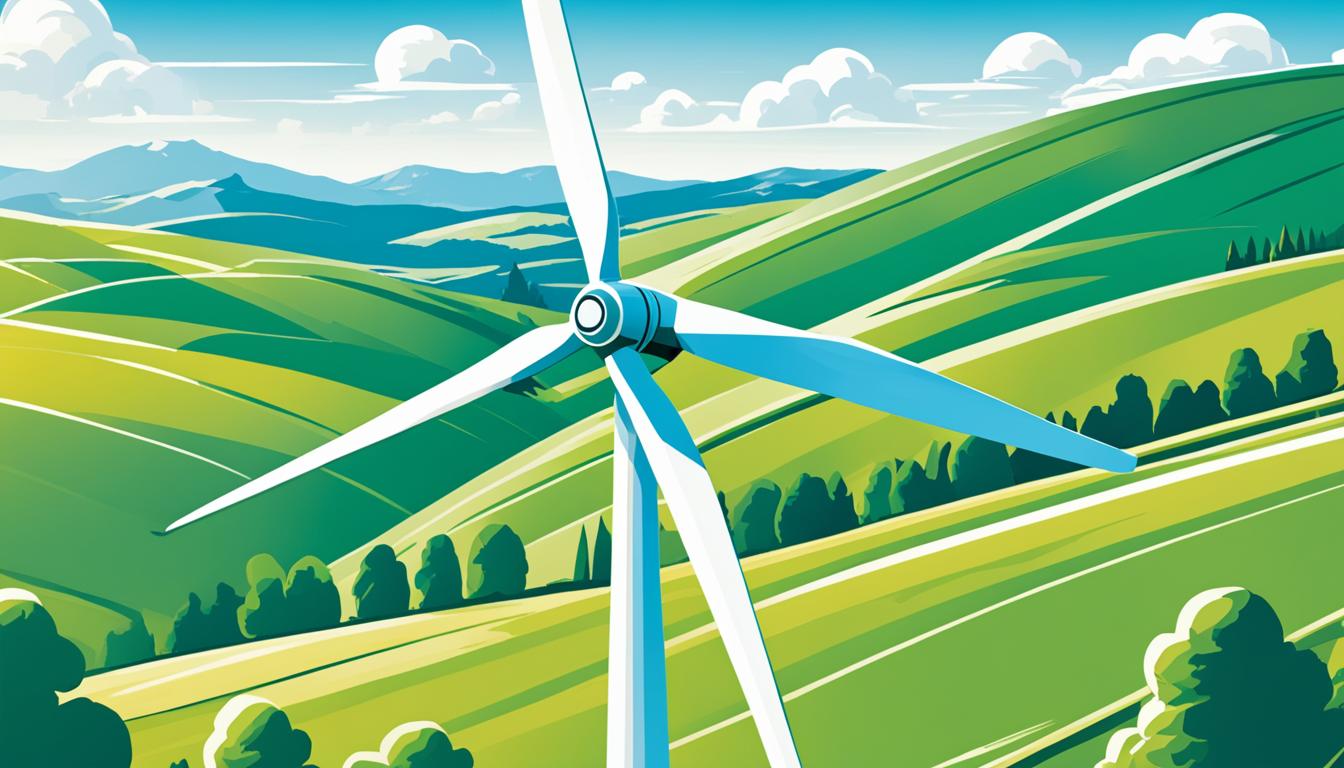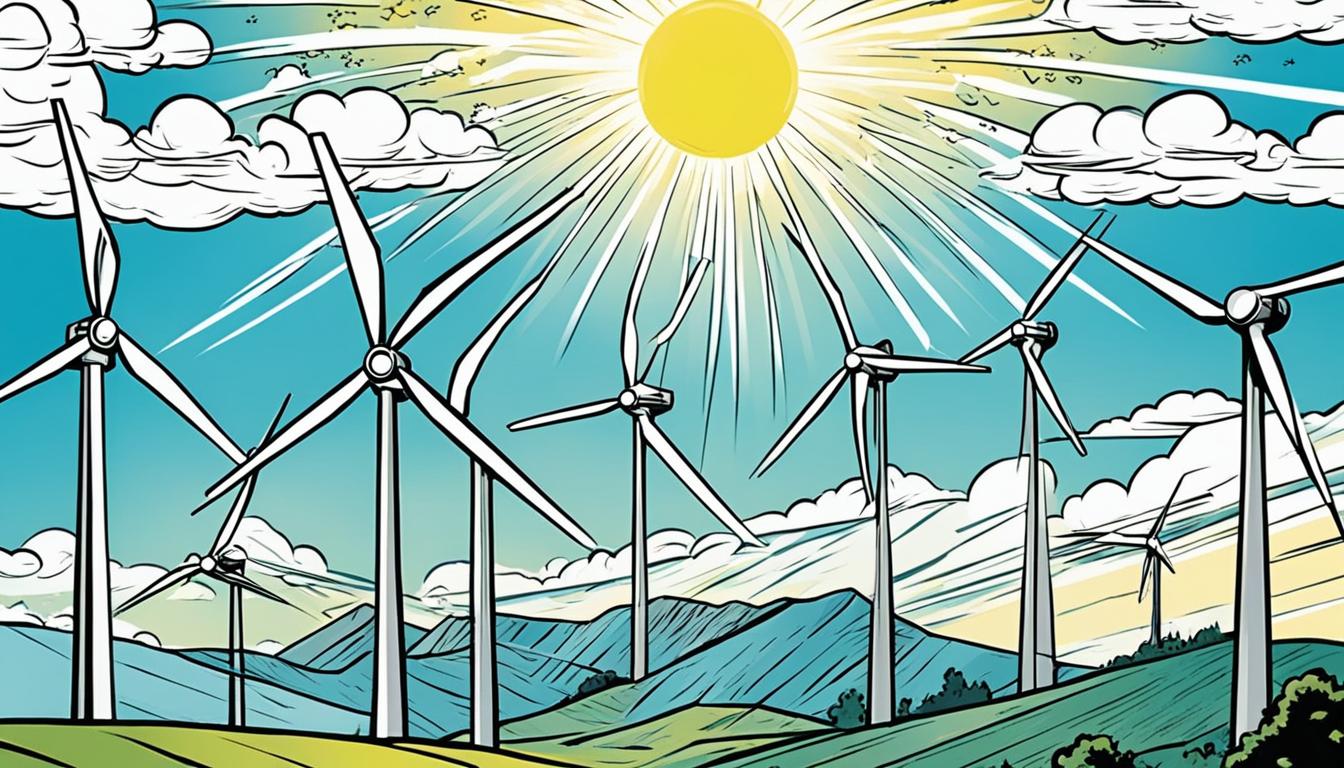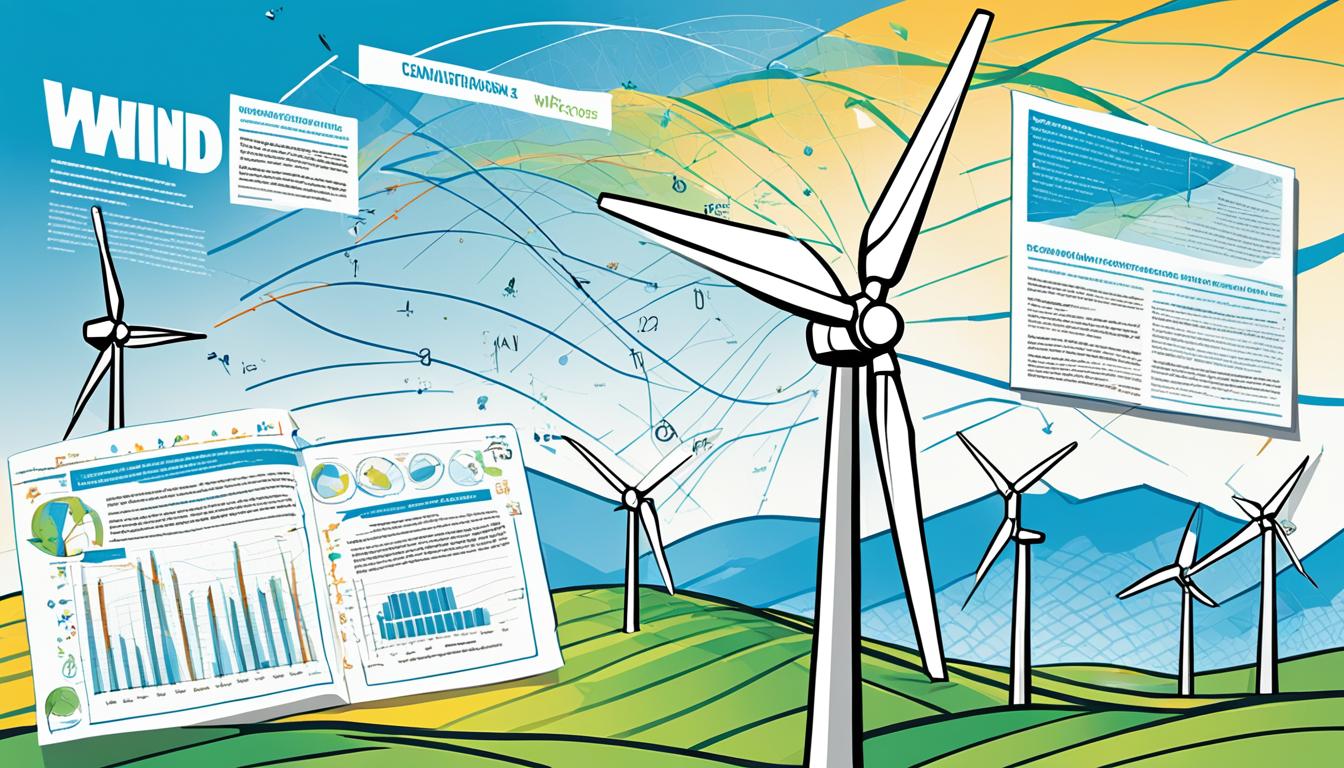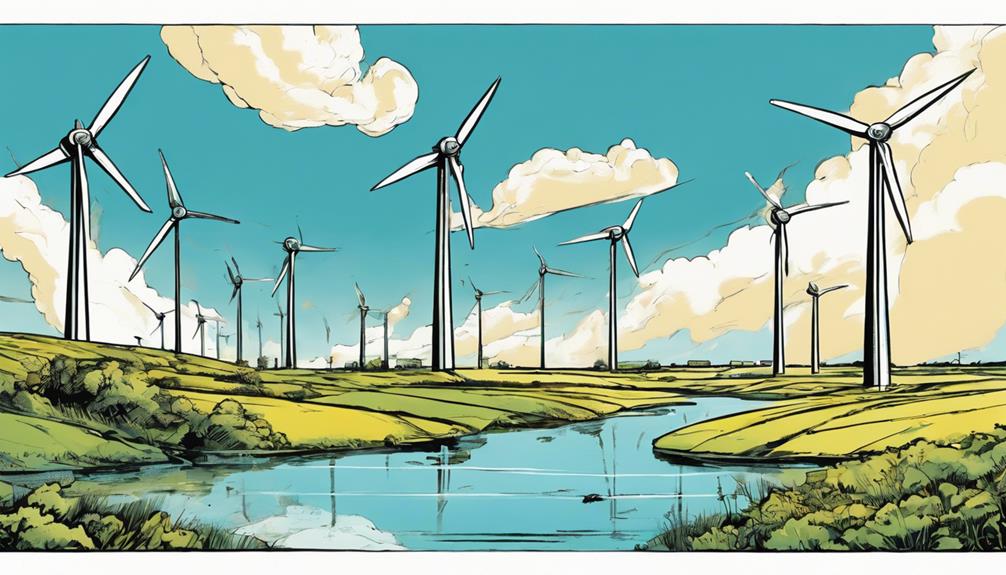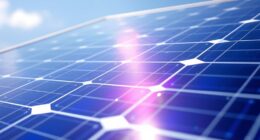In the U.S., electricity generation contributes approximately 25% of national greenhouse gas emissions1, making it a major contributor to climate change. To reduce their carbon footprint, many people are considering installing renewable energy systems like wind turbines or solar panels in their homes. Both options have pros and cons, depending on factors such as space availability, geographical location, and budget.
Key Takeaways:
- Electricity generation accounts for 25% of national greenhouse gas emissions in the U.S1.
- Residential wind turbines and solar panels are eco-friendly home energy solutions1.
- Solar panels offer a reliable and sustainable source of energy with an average efficiency of 15% to 20%12.
- Wind turbines can produce between 400 watts to 20 kilowatts of energy, depending on wind speed and location12.
- The initial cost of a home solar system typically ranges from $15,000 to $25,000 for a 5-kilowatt system1.
- Wind power has a lower carbon footprint compared to solar power, emitting about 4 grams of carbon dioxide equivalent per kilowatt-hour produced1.
- Combining solar and wind power offers a cost-effective and reliable option for residential energy needs2.
Benefits of Solar Panels for Home Energy
Solar panels offer numerous benefits for homeowners seeking to harness renewable energy to power their homes. With advancements in technology and increasing affordability, solar power has become a popular choice for residential energy solutions. Let’s explore the advantages of installing solar panels for home energy:
- Clean and Renewable Energy: Solar panels generate electricity by converting sunlight into usable energy, providing a clean and renewable source of power for homes. This sustainable energy option helps reduce dependence on fossil fuels and decreases carbon emissions, contributing to a greener environment3.
- Lower Energy Bills: Installing solar panels can significantly lower energy bills by generating free electricity from the sun. Homes with solar panels can offset a significant portion of their electricity needs, leading to substantial savings over time. As a result, homeowners can enjoy reduced monthly expenses and long-term financial benefits4.
- Increased Home Value: Solar panels have been shown to increase the value of residential properties. Studies have found that homes equipped with solar panels can have a higher resale value compared to those without solar installations. On average, solar panels can increase a home’s value by approximately $15,000, making them a valuable investment for homeowners5.
- Financial Incentives: Government incentives and tax credits are available for residential solar panel installations, making them more affordable for homeowners. The federal tax credit for solar energy systems provides a significant financial incentive for adopting solar power. In recent years, the tax credit has been as high as 30%, with gradual reductions scheduled in the coming years5.
- Long Lifespan: Solar panels are durable and built to withstand various weather conditions. They typically have a lifespan of 25 to 30 years, providing homeowners with decades of reliable energy production and cost savings4.
In addition to these benefits, solar panels require minimal maintenance, further enhancing their appeal for homeowners. Regular cleaning and occasional inspections are recommended to ensure optimal performance, but overall, solar panels offer a hassle-free and efficient solution for home energy needs.
| Solar Panels | Wind Turbines | |
|---|---|---|
| Energy Generation | Solar panels generate electricity from sunlight, offering a consistent and reliable source of power throughout the day. | Wind turbines harness wind energy to generate electricity, making them dependent on wind speed and consistency. |
| Installation Suitability | Solar panels are versatile and can be installed on various residential properties, including rooftops and open spaces. | Wind turbines require significant space and specific wind conditions, making them more suitable for rural or large-scale installations. |
| Environmental Impact | Solar panels produce clean energy and have a minimal environmental footprint, resulting in reduced greenhouse gas emissions and air pollution. | Wind turbines also produce clean energy, but their larger size and noise levels may have some environmental considerations and visual impact. |
| Cost | The cost of solar panel installations can range between $20,000 to $40,000, depending on factors such as system size and installation complexity. However, the long-term savings on energy bills offset the initial investment. | Wind turbines generally have higher upfront costs, with prices ranging from tens of thousands to millions of dollars, primarily due to the turbine’s cost and installation requirements. |
| Efficiency | Solar panels have an average efficiency of around 20%, with the most efficient panels reaching efficiency levels of up to 25%. | Wind turbines can harness about 50% of the energy that passes through them, making them more efficient in converting wind power into electricity compared to solar panels. |
In conclusion, solar panels offer numerous benefits for homeowners, including clean and renewable energy generation, lower energy bills, increased property value, and various financial incentives. With their long lifespan and low maintenance requirements, solar panels are a reliable and cost-effective solution for home energy needs. By harnessing the power of the sun, homeowners can contribute to a greener future while enjoying the advantages of sustainable and affordable electricity.
Considerations for Solar Panel Installation
When considering solar panel installation, several factors need to be taken into account. The overall cost of a residential solar system is typically between $15,000 and $25,000, depending on the size and capacity of the system6. Federal investment tax credits and state and local incentives are available to offset these costs.
It’s important to consider the efficiency of solar panels, which can vary between 15% and 20%7. Most at-home solar systems are connected to the grid, allowing homeowners to sell excess energy back to utility companies.
Having a solar battery bank can provide energy independence during times of low sunlight or grid outages, but it can add significant costs to the overall installation6.

When it comes to the cost of solar panels, it’s important to consider the long-term savings. Solar energy is more reliable and cheaper to install and maintain than other renewable energy sources, making it the most preferred and dominant source for clean energy6. Solar panels often come with extended warranties of 25 years or more, ensuring their long-term performance and reliability8.
Additionally, government rebates and tax cuts have significantly reduced the cost of solar installations, making it more affordable for homeowners6.
Another factor to consider is the maintenance required. Once installed, solar panels require very limited maintenance compared to wind turbines, making them a hassle-free option for homeowners8. Solar panels are also considered less conspicuous and do not generate noise, which can be a concern with wind turbines8.
Lastly, solar panels can be installed on almost any roof with the right orientation and angle, making them a versatile option for residential use8.
| Considerations for Solar Panel Installation | Statistical Data References |
|---|---|
| Overall cost of residential solar system | 6 |
| Solar panel efficiency | 7 |
| Availability of federal tax credits and incentives | 6 |
| Ability to sell excess energy back to utility companies | 7 |
| Importance of solar battery bank | 6 |
| Cost-effectiveness of solar panels | 6 |
| Extended warranties for solar panels | 8 |
| Government rebates and tax cuts | 6 |
| Maintenance requirements for solar panels | 8 |
| Conspicuousness and noise generation | 8 |
| Versatility of solar panel installation | 8 |
Pros and Cons of Wind Turbines for Home Energy
When considering renewable energy options for home energy, wind turbines are a viable choice that harness the power of wind to generate electricity. While they offer several advantages, they also come with some drawbacks. Let’s explore the pros and cons of using wind turbines for residential energy needs.
Pros of Wind Turbines
- Efficient Energy Generation: Wind turbines have higher efficiency compared to solar panels, with the ability to harness about 50% of the wind energy that passes through them9.
- Constant Energy Generation: Wind turbines can generate power 24 hours a day, making them less dependent on sunlight unlike solar panels10.
- Large Energy Output: A single wind turbine can generate the same amount of electricity in kWh as thousands of solar panels10.
- Cost-Competitive: Wind power costs are competitive with more conventional energy technologies11.
- Offshore Potential: For coastal states like Virginia, Massachusetts, and New Jersey, offshore wind power presents a significant investment opportunity9.
Cons of Wind Turbines
- Geographical Limitations: Wind turbines work best in large expanses of land without obstructions like trees or buildings. States like Texas, Oklahoma, Iowa, Kansas, and Illinois, with their open and flat areas, are leaders in wind energy9.
- Higher Installation and Maintenance Costs: Wind turbines can be more expensive to install and maintain compared to solar panels. Their moving parts require regular check-ups and can be prone to wear and tear9.
- Aesthetic Concerns: Wind turbines may raise aesthetic concerns in residential areas, impacting the visual landscape11.
- Noise Pollution: Wind turbines can generate noise, which can be a concern for nearby residents11.
- Potential Environmental Impacts: Wind turbines can potentially harm local ecosystems and wildlife11.
- Challenging Capitalization: While wind power is technically more efficient, capitalizing on wind resources can be challenging10.

In conclusion, wind turbines offer efficient and constant energy generation for residential use. However, they have geographical limitations, higher installation and maintenance costs, and potential aesthetic and environmental impacts. To determine the optimal choice for home energy, it is essential to consider factors such as geographical location, budget, and personal preferences.
Factors to Consider for Wind Turbine Installation
When contemplating the installation of a wind turbine for residential energy production, several factors should be taken into account. The decision to incorporate wind energy into your home requires careful consideration of cost, maintenance, and efficiency.
1. Wind Turbine Cost
Wind turbines can vary in cost depending on factors such as size and capacity. According to the American Wind Energy Association, the approximate cost of a wind turbine is $1.50 per watt of generating capacity12. For example, a 10 kW wind turbine may cost around $14,700 after incentives12. It is important to note that the initial expense of purchasing and installing a wind turbine for residential use is generally lower compared to solar panels13.
2. Wind Turbine Maintenance
Regular maintenance is required for wind turbines to ensure optimal performance and longevity. Wind turbines may necessitate maintenance two to three times per year, incurring additional expenses that can quickly accumulate to thousands of dollars annually12. Unlike solar panels, wind turbines consist of moving parts, making them more susceptible to wear and tear. It is essential to factor in these recurring maintenance costs when considering wind turbine installation12.
3. Wind Turbine Efficiency
Wind turbines have a higher efficiency rate compared to solar panels. While solar panels typically have an efficiency rate of around 15%, wind turbines can achieve efficiencies of approximately 40%13. This means that wind turbines can generate more electricity per square foot than solar panels. It is important to consider the efficiency of wind turbines when assessing the potential energy production for your residential wind system13.
4. Location and Wind Speed
Residential wind turbines require specific wind conditions to operate optimally. It is crucial to assess the average annual wind speed in your location. Grid-connected wind turbines are practical if the average annual wind speed is at least 9 miles per hour, and utility electricity costs are high14. Additionally, wind turbines need to be placed in areas where there are no obstructions, such as tall buildings or trees, that can disrupt the wind flow. Careful consideration of these factors is necessary to ensure the effectiveness of a residential wind system.
5. Energy Output and Contribution
The energy output of a wind turbine depends on various factors, including the wind turbine power curve, average annual wind speed, tower height, and wind frequency distribution14. A wind turbine rated between 5-15 kilowatts is needed to significantly contribute to the electricity demand of a home consuming about 877 kilowatt-hours per month14. An estimate of the annual energy output should be considered to evaluate the feasibility of incorporating wind energy into your residential electrical supply14.
6. Environmental Impact
Wind power has a lower carbon footprint compared to traditional electricity generation methods. By utilizing wind energy, homeowners can reduce their dependence on fossil fuels and reduce greenhouse gas emissions. Incorporating wind energy into your residential energy mix can contribute to a cleaner and more sustainable future.
In conclusion, the installation of a wind turbine for residential energy production involves careful consideration of various factors such as cost, maintenance, efficiency, location, and environmental impact. While wind turbines may have a higher upfront cost and maintenance expenses compared to solar panels, they offer higher efficiency and the potential for significant energy contribution. Assessing these factors will help determine if wind turbine installation is a suitable choice for your home energy needs.
Comparison of Solar Panels and Wind Turbines
When considering renewable energy options for residential use, two popular choices are solar panels and wind turbines. Both technologies offer clean and sustainable energy solutions, but they have distinct characteristics that make them suitable for different situations. Understanding the advantages and limitations of each can help homeowners make an informed decision about which system best suits their needs. Let’s compare solar panels and wind turbines in terms of energy production, environmental impact, and suitability for different locations.
Energy Production
Solar panels harness sunlight and convert it into electricity through photovoltaic cells, typically made of silicon. Over the years, solar panels have become more efficient, with various shapes and sizes available for different applications. In fact, solar energy is the fastest-growing energy source in the United States, with over 160 gigawatts of solar installed as of the third quarter of 202315. Solar panels can generate electricity for nearly 30 million homes and have been growing at an average rate of 24% per year over the last decade15. The versatility of solar panels allows them to be installed on rooftops of buildings, schools, and businesses, as well as integrated into facades, roofs, windows, and patio umbrellas1516.
On the other hand, wind turbines harness the kinetic energy of wind and convert it into electricity through the rotation of their blades. While wind power capacity in the United States totals nearly 150 gigawatts15, wind turbines are not as widely adopted as solar panels for residential use due to their specific geographical requirements. Wind turbines are mostly located in rural regions and are not suitable for densely populated areas17. However, it is worth noting that wind turbines release less CO2 to the atmosphere and consume less energy while producing more overall energy compared to solar panels17. In fact, one wind turbine can generate the same amount of electricity as seven football fields of solar panels17.
Environmental Impact
Both solar panels and wind turbines have a positive impact on the environment compared to traditional energy sources. Solar panels generate electricity without emitting greenhouse gases, contributing to clean energy production and reducing carbon emissions16. Wind turbines, similarly, generate electricity without burning fossil fuels and have a minimal carbon footprint16. By harnessing renewable energy, both solar panels and wind turbines help reduce dependence on non-renewable resources and combat climate change.
Suitability for Different Locations
Solar panels are versatile and can be installed in various locations, including residential buildings, schools, and businesses15. They are particularly suitable for areas with ample sunlight and available space. On the other hand, wind turbines require consistent wind patterns and are mostly located in rural regions17. To maximize the potential of wind energy, wind turbines need to be installed in areas with high average wind speeds and space for the turbine’s height and blade span. Therefore, wind turbines are more suitable for open and less densely populated areas with consistent wind resources.
In conclusion, solar panels and wind turbines are both viable options for residential renewable energy. Solar panels are versatile, accessible, and have experienced rapid growth in recent years15. On the other hand, wind turbines offer higher energy efficiency but require specific geographical conditions17. The choice between solar panels and wind turbines will depend on individual circumstances, such as available space, geographical location, and energy needs. It is important to carefully consider these factors to make an informed decision and contribute to a sustainable future.

| Comparison | Solar Panels | Wind Turbines |
|---|---|---|
| Energy Production | Convert sunlight into electricity through photovoltaic cells | Convert wind energy into electricity through rotating blades |
| Environmental Impact | Generate electricity without emitting greenhouse gases | Generate electricity without burning fossil fuels |
| Suitability for Different Locations | Can be installed on rooftops, buildings, schools, and businesses | Require consistent wind patterns and open spaces |
Environmental Impact of Solar Panels and Wind Turbines
When it comes to the environmental impact of renewable energy systems, solar panels and wind turbines offer significant advantages over traditional fossil fuel power sources. Solar panels, for instance, generate clean, renewable energy without emitting greenhouse gases during their operation. This makes them an excellent choice for homeowners looking to reduce their carbon footprint. However, it’s important to consider the entire life cycle of solar panels, including their manufacturing and recycling processes18. These processes can have environmental implications due to the use of toxic chemicals and the challenges associated with recycling certain materials. Nonetheless, once installed, solar panels provide long-term clean energy and contribute to a more sustainable future18.
On the other hand, wind turbines also contribute to reducing carbon emissions and reliance on fossil fuel-generated electricity. According to estimates, wind turbine life-cycle global warming emissions range between 0.02 and 0.04 pounds of carbon dioxide equivalent per kilowatt-hour, which is lower compared to natural gas-generated electricity and coal-generated electricity19. However, wind turbines have their own set of environmental considerations. Their installation and operation can affect natural habitats and pose risks to bird populations18. The noise generated by turbines can disturb terrestrial and marine life, and the disposal of wind turbine blades in landfills presents a challenge for efficient recycling18. As the renewable energy industry continues to expand rapidly, the volume of waste generated from aging wind turbines and solar panels is expected to increase in the future18.
When choosing between solar panels and wind turbines for home energy, it’s crucial to weigh the environmental benefits against the potential drawbacks. Both options play a crucial role in reducing greenhouse gas emissions and transitioning to a more sustainable energy system. However, it’s essential to consider factors such as the materials used, manufacturing processes, disposal methods, and impacts on biodiversity and natural habitats. By understanding the full environmental impact of these technologies, homeowners can make informed decisions that align with their sustainability goals1918.
It is clear that solar panels and wind turbines provide tangible benefits in terms of carbon reduction and renewable energy generation. However, achieving a sustainable future requires a comprehensive approach that balances climate action with conservation efforts. This includes careful planning and collaboration among stakeholders to ensure the responsible development and placement of renewable energy projects. By incorporating solar panels and wind turbines on appropriate lands, such as agricultural areas, undisturbed habitats can be conserved, contributing to a win-win scenario for renewable energy and the environment1820.

The Environmental Impact at a Glance
Below is a summary of the environmental impact of solar panels and wind turbines:
| Environmental Aspect | Solar Panels | Wind Turbines |
|---|---|---|
| Carbon Footprint (pounds of CO2 equivalent per kilowatt-hour) | Minimal emissions during operation | 0.02-0.0419 |
| Lifespan | 25-30 years18 | |
| Disposal Challenges | Difficulty in recycling certain materials18 | Blades often end up in landfills18 |
| Impact on Natural Habitats | Minimal | Disturbance and collision risks for wildlife18 |
| Waste Generation | Expected increase from aging turbines and panels18 |
Note: The data provided above are based on statistical insights from various sources referenced throughout this section.
By considering the environmental impact of solar panels and wind turbines, homeowners can make environmentally-conscious choices in their pursuit of clean, renewable energy systems. While both technologies have their unique pros and cons, their contribution to mitigating climate change cannot be overlooked. Ultimately, it is essential to strike a balance between harnessing the benefits of renewable energy and minimizing any negative impacts on the environment.
Renewable Energy Combination: Solar Panels and Wind Turbines
For homeowners seeking a comprehensive and sustainable home energy solution, the combination of solar panels and wind turbines presents a powerful option. By harnessing the complementary benefits of both solar and wind power, a hybrid system can provide a reliable and continuous supply of clean energy21.
Solar panels are highly efficient energy generators, particularly during daylight hours when sunlight is abundant22. On the other hand, wind turbines excel in producing electricity during nighttime hours and in areas with strong and consistent winds22. Integrating these two systems allows for better energy planning and a more consistent year-round energy supply22.
Combining solar panels and wind turbines maximizes energy production by utilizing varied outputs based on specific weather conditions. When sunlight decreases, wind often increases, making wind turbines and solar panels a perfect combination for optimized energy production21.
One advantage of wind turbines over solar panels is their continuous power generation potential. Wind turbines generate electricity as long as there is wind, whereas solar panels reach equilibrium and discard incoming power they don’t need21. However, wind turbines perform better when mounted higher above the ground, so selecting an appropriate location for installation is crucial21. On the other hand, solar panels with a time tracker can maximize sun exposure throughout the day, allowing for efficient energy capture21.
Hybrid charge controllers provide a seamless solution for combining wind turbines and solar panels in a hybrid system setup. These controllers allow for simultaneous charging of batteries from both energy sources, ensuring optimal utilization of available energy21.
Additionally, starting with a hybrid setup early on makes future expansions of wind and solar hybrid systems easier and more flexible21. Depending on energy output preferences, further turbines or panels may be added to the hybrid system, optimizing energy production and further reducing reliance on the grid21. In some cases, adding output components such as a DC Water Heating Element can serve as a power dump for excess production21.
Combining a wind turbine and solar panel system offers homeowners flexibility, efficiency, and increased energy independence. In many cases, it is the preferred and practical choice for those seeking a comprehensive approach to renewable energy generation21.
It’s important to note that while combining solar panels and wind turbines in a hybrid system offers numerous benefits, it is crucial to consider the upfront costs, maintenance requirements, and available space before making a decision21. Homeowners should evaluate their energy needs, local weather conditions, and budget to determine the viability and suitability of a hybrid system21.
| Renewable Energy Combination: Solar Panels and Wind Turbines | |
|---|---|
| Solar panels | Wind turbines |
| Offer efficient energy generation during daylight hours22 | Generate electricity during nighttime hours and strong winds22 |
| Maximize sun exposure with time trackers21 | Perform better when mounted higher above the ground21 |
| Reach equilibrium and discard excess power21 | Continuously generate power as long as wind blows21 |
| Can be combined with wind turbines to maximize energy production21 | Can be combined with solar panels to optimize energy output21 |
By integrating solar panels and wind turbines in a hybrid system, homeowners can achieve a more reliable, efficient, and sustainable home energy solution that reduces their carbon footprint and dependence on the grid2122. While the initial investment and maintenance considerations should not be overlooked, the long-term benefits and environmental impact make this combination a compelling choice for clean energy options2122.

The Cost of Solar Panels vs. Wind Turbines
When considering renewable energy options for home energy, one of the crucial factors is the cost of installation and maintenance. The cost of solar panels and wind turbines varies depending on several factors, including size, capacity, local incentives, and installation requirements. On average, solar panel installation costs range from $15,000 to $25,000, while residential wind system costs average around $41,50023.
Solar panels tend to have lower upfront costs compared to wind turbines, making them a more accessible choice for homeowners. Additionally, solar energy installation costs around $2.19 per watt, while wind power installation costs approximately $1.50 per watt24. These figures demonstrate that wind turbines generally have higher installation costs compared to solar panels.
However, it is important to consider the energy production capacity of each system when evaluating long-term costs. Wind turbines have the potential to produce more energy compared to solar panels. A 10 kW wind turbine can generate an average annual production of around 14,016 kilowatts per hour, while a 10 kW PV solar system has an average annual production of 14,165 kWh23.
Although wind turbines may have higher upfront costs, their higher energy yield can offset these expenses over time. Additionally, wind turbines have a lower carbon footprint compared to solar panels, making them an environmentally friendly choice24.
In contrast, solar panels have lower maintenance requirements, resulting in lower ongoing costs for homeowners24. Wind turbines, on the other hand, may require more frequent maintenance and repairs, contributing to higher long-term costs24. It’s essential to consider this aspect when making a decision about investing in renewable energy.
Overall, the cost of solar panels and wind turbines for home energy depends on various factors, including installation costs, energy production capacity, and maintenance expenses. It is important to evaluate the long-term financial benefits and environmental impact of each option before making a decision23. Ensuring a sustainable and cost-effective energy solution for your home is key to maximizing the benefits of renewable energy sources.
The Efficiency of Solar Panels vs. Wind Turbines
When considering renewable energy options for home energy generation, the efficiency of solar panels and wind turbines is a crucial factor to examine. Solar panels have an average efficiency of 15% to 20%25, meaning they can convert 15% to 20% of sunlight into usable energy. In contrast, wind turbines can harness up to 60% of the wind energy that passes through them26. This higher efficiency of wind turbines makes them more effective in terms of energy production.
However, it’s important to note that solar panels can still meet a significant portion of a household’s energy needs, especially with proper installation and sufficient sunlight exposure. For example, an average household of six people would require around 24 solar panels to meet their energy demands, generating between 6,000 and 10,000 kWh a year26. The cost per kWh for solar panels is approximately 4.6 cents26. On the other hand, a 5kW wind turbine could produce enough energy for a household of six people, equivalent to the output of 24 solar panels26. However, the average installation cost of a wind turbine ranges between $50,000 and $70,000, with an average cost of 20.3 cents per kWh26.
In terms of efficiency comparison, wind turbines outperform solar panels. However, there are other factors to consider, such as geographical location, available space, and energy requirements. Solar power is described as less expensive than wind power, making low-cost installation and lower maintenance requirements of solar panels a preferred option for homeowners seeking renewable energy solutions26. Additionally, solar panels are suitable for urban settings due to their space-saving design, while wind turbines work best in open landscapes25. Wind power is often sourced remotely in elevated locations and can significantly reduce electricity bills for consumers27.
It’s important to keep in mind that both solar panels and wind turbines have their advantages and disadvantages. Solar panels rely on sunlight availability, causing intermittency issues25. Conversely, wind energy generation is dependent on wind speed, also indicating potential intermittency25. Furthermore, improper disposal of solar panels can lead to harmful pollution25, and wind turbines can disturb local wildlife, particularly birds25.
| Solar Panels | Wind Turbines | |
|---|---|---|
| Efficiency | 15% to 20% (average)25 | Up to 60%26 |
| Installation Costs | Estimated between $11,000 and $15,000 for an average household of six26 | Average installation cost ranges between $50,000 and $70,00026 |
| Cost per kWh | Approximately 4.6 cents26 | Average cost of 20.3 cents per kWh26 |
| Geographical Suitability | Suitable for urban settings with limited space25 | Work best in open landscapes, rural settings25 |
| Environmental Impact | Low pollution, improper disposal may cause harm25 | Does not pollute the environment, may disturb wildlife, particularly birds25 |
Given the above considerations, a combination of solar power with wind power is suggested as the best option for powering homes through multiple renewable energy sources. This hybrid approach is particularly suitable for rural communities with ample space, providing better efficiency and reliability2625. Furthermore, decentralized systems such as solar panels and wind turbines are considered less prone to complete failure compared to centralized power plants, enhancing sustainability and resilience in energy generation27.
Conclusion
After considering the benefits, considerations, and statistical data, it is evident that both wind turbines and solar panels offer viable renewable energy solutions for homes. Solar energy has experienced tremendous growth in recent years, with the ability to generate steady and predictable energy outcomes28. Solar panels are versatile and can be conveniently placed in various open spaces with direct sunlight availability28. They operate silently and have relatively lower maintenance costs compared to wind turbines28. Additionally, solar panels have seen a significant drop in price, making them a cost-effective option for homeowners29.
On the other hand, wind turbines have been used for centuries and can generate energy even at night when there is no sunlight28. They can work as a sustainable source of energy in locations with a constant flow of wind throughout the year28. Wind turbines offer a higher capture rate of energy, averaging around 60% compared to solar panels’ 18-22%29. However, they are often limited to windy rural areas and may face visual and noise-related challenges30.
Ultimately, the choice between wind turbines and solar panels for home energy depends on individual circumstances, such as geographical location, space availability, and budget. For city and suburban homes with ample sunlight and lower maintenance requirements, solar panels may be a more suitable option. However, in windy rural areas, wind turbines can provide higher energy efficiency. Combining both solar panels and wind turbines can offer a comprehensive renewable energy solution for homeowners29. Furthermore, for homeowners looking to power larger appliances such as central air conditioning systems, a combination of both wind turbines and solar panels may be necessary to meet the energy demands. This can help ensure a more consistent and reliable energy supply, especially during times of low sunlight or wind. Additionally, considering the environmental benefits and potential cost savings in the long run, investing in a combination of both wind and solar energy systems may be a wise choice for many homeowners.
It is recommended to consult with a professional to assess specific energy needs and determine the best option for home energy generation. Regardless of the choice, transitioning to renewable energy sources like wind and solar is crucial for reducing carbon footprint and contributing to a greener future.
